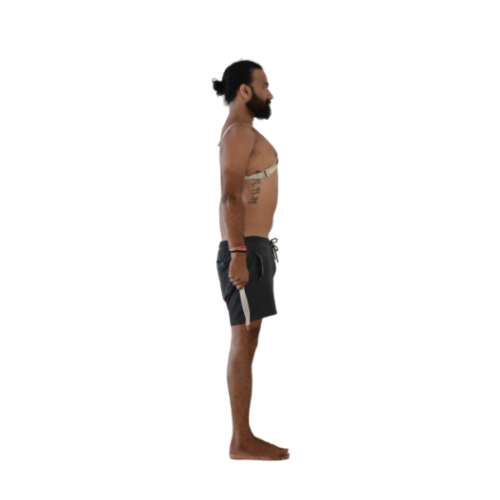What is Tadasana / Mountain Pose?
Mountain pose or Samasthiti is a standing asana in yoga. Tadasana is from the Sanskrit words tada, “mountain” and asana meaning “posture” or “seat”. Tadasana is the basic standing asana on which many other poses are founded. It is used in schools of yoga in between other poses, to allow the body and consciousness to integrate the experience of the preceding asana and to prepare for the next.
From Sanskrit to English:
Sanskrit pronunciation: Tadasana (tah-DAHS-anna)
Meaning: tada = mountain
In Ashtanga Vinyasa Yoga, Tadasana is also referred to as Samasthiti (Equal Standing Pose). The only difference is that while in Tadasana the feet can be apart, Samasthiti is usually practiced with the feet together. That said, practitioners can keep their feet apart in Samasthiti as well, just as long as the outer edge of their heels are parallel.
As its name Mountain Pose also indicates in English, when practiced with intention, this pose can have us find the mountain present within each of us – embodying its qualities of strength and stability.
Benefits of the Tadasana / Mountain Pose
+ Improves posture and alignment
+ Tones abdomen muscles and buttocks
+ Strengthens the arms and legs
+ Improves balance and focus
+ Reduces flat feet
+ Relieves sciatica
Yoga for every BODY
While we appear to simply be standing at the front of our mats when practicing Tadasana, there are so many refinements to this pose. The three modifications we have included below are meant to help your body memorize the correct alignment to maximize the benefits of practicing this pose.
Standard Tadasana
1. Stand with your feet together and parallel to one another (If needed, move your heels slightly apart so that the outer edge of your feet are parallel); your heels, hips, head in one line and your arms alongside your body.
2. Lift and spread your toes before placing them back on the floor. Then, press evenly into the four corners of your feet.
3. Straighten your legs (without locking the knees) and lift your knee the inner arches of your feet, your ankles and knee caps firming your thigh muscles, turning them slightly inward.
4. Lengthen your tailbone towards the ground, activate your mula bandha (root lock) and gently tilt your pubis towards your navel.
5. Activate your uddiyana bandha (abdominal lock) to send the energy up through your core, torso, all the way to the crown of your head.
6. Broaden your shoulder blades and draw them away from the ears. Keeping the lower front ribs in place, open your chest and lift your heart slightly towards the sky.
7. Engage your biceps and have your palms facing forward or to the sides, with your fingers extended, together or apart.
Modification 1: Supporting the upper body
Using a strap to support the upper body helps drawing the shoulders away from the ears and allows for the chest to open while staying aligned.
A

1. Stand up tall. Place a strap around your back, under your shoulder blades, with each end coming out from under your arms.
2. Cross each strap end to the front, placing them over the opposite shoulder.
3. Take the ends of the straps from underneath and cross them again over your back.
4. Holding onto the ends of each strap, gently pull towards the floor.
Modification 2: Supporting the sacrum
Placing a block between the wall and your sacrum will help you send your tailbone towards the ground and prevent you from arching your lower back. This can enable you to understand the expected alignment in Tadasana and help you improve your posture over time.
B

1. Grab a block and stand approximately 20 cm away from the wall.
2. Place a block between you and the wall, its shorter edge at the level of your sacrum.
3. Follow the instructions for a Standard Tadasana.
Modification 3: Supporting the lower body
Placing a block between your feet will help you engage the inner arch of your feet and activate your legs. The strap prevents the knees and thighs from rotating outward. Instead, the strap will keep the knees in place and enable the slight inner rotation of the thighs that are meant to happen in Tadasana.
C

1. Grab a block and a loose strap. Place the block on its lower height between your feet, the shorter edge of the block facing forward. Place the strap around your thighs, loop it and tighten it right above your knees.
2. Follow the instructions for a Standard Tadasana, pressing the inner arches of your feet against the longer sides of the block and focusing on rolling the inner thighs slightly inward.
Interested in becoming a yoga teacher?
Newsletter
Upcoming events and latest blogs